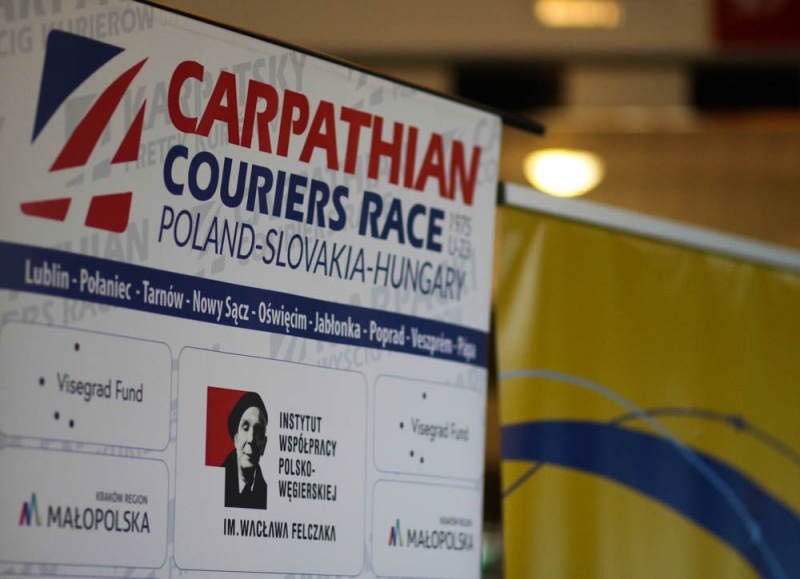
The thirty-seventh Carpathian Courier Race will be held on 31 August 2020. Its beginnings date back to 1975, when the first "Beskid Courier Trail" International Cycling Race took place. The aim of the event was to commemorate and pay tribute to the couriers of the Polish Underground State, who were clandestinely making their way from Poland to Hungary through Slovakia during World War II. Initially, the race took place on the Tarnów-Poprad or Poprad-Tarnów route, and it led through towns that were visited by Polish couriers in the past: Nowy Sącz, Piwniczną–Zdrój, Rytro, Tuchów, Ciężkowice and many others. Young cyclists from Poland, Hungary and the former Czechoslovakia took part in the competition. The race first came to Hungary in 1988, in its fourteenth year. The route led from Miskolc, through Poprad all the way to Tarnów. The last "Beskid Courier Trail" International Cycling Race was held in 2000. In 2009 it was reactivated under the name "Carpathian Couriers Race". Initially, the cyclists raced in Poland and Slovakia, and sometimes in the Czech Republic. Since 2014, the race route has once again been running between Poland and Hungary. Cyclists between 19 and 22 years old take part in the competition. The event is included by the International Cycling Union in the annual Europe Tour calendar and is considered to be one of the most important events for youth cyclists in Europe. In 2019, Wacław Felczak became the patron of the race and the Wacław Felczak Polish-Hungarian Cooperation Institute became an official partner of the general classification. Twenty-four teams from all over the world lined up at the start, and half of them represented the colours of the co-organisers: Poland, Slovakia and Hungary. The start of the 37th race was scheduled for 28 April 2020, and the event was to last until 3 May. At first the it was to start from Budapest. The coronavirus pandemic forced the organizers to make changes. The thirty-seventh Carpathian Courier Race will be held on 31 August 2020, on the eve of the anniversary of the outbreak of World War II. It will be a one day event. The route of this year's edition will be a reconstruction of the historical, first stage of the first edition of the Courier Race organized forty-five years ago. The competitors will start from Hungarian Square in Tarnów, under the monument to General Józef Bem. Then through Skrzyszów, Ryglice, Pleśną, Zakliczyn and Gromnik will race all the way to Ciężkowice. The organizers say that next year the race will start from Budapest and the competition will last six days.
It is worth remembering the extensive cycling traditions in Hungary. The history of cycling on the banks of the Danube goes back to 1878. The first cycle was brought there by one of the engineers form from Lincoln, UK. However, it was a primitive and obsolete design. A year later, László Kosztovits, president of one of the local English cycling clubs, brought the first modern bicycle to Budapest. In Easter 1881 Kosztovits organized the first cycling trip in Hungary. At six o'clock in the morning a group of cyclists left the city park near the centre of Budapest and arrived in Gödöllő at two in the afternoon. It took the expedition eight hours to complete the thirty-kilometre stretch. As the road had fewer holes and was less bumpy than the others, it soon became the most popular cycling route around the capital. Initially, cycling was compared to horseback riding and the new mode of transport was mainly used by aristocrats. Soon, cycles became very popular in Hungary and many people, such as postmen and shopkeepers started to use it for their work.
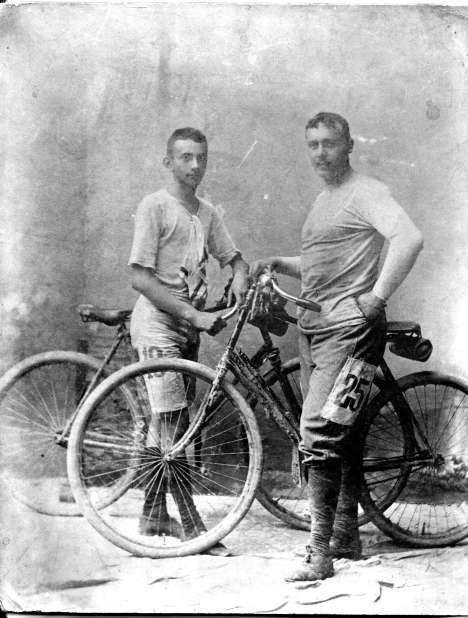
Participants of the first road "set distance cycling race" which took place in 1894 between Budapest and Pécs.
In 1885 thirty-three cyclists founded Budapest Bicycle Association. The organization of group trips continued, and the kilometres travelled were carefully recorded. In its first year, during 239 trips, the group travelled a total of 23,606 kilometres. Emil Philipovics clocked up the most: 4,099 kilometres. In 1889 at a meeting of cycling associations in Szombathely, the Hungarian Cycling Association was established, which however, due to organizational problems soon ceased to exist. Five years later, on 3 May 1894, the organisation was reactivated –- this time as a national federation. Dr. György Gerenday stood at its helm. The Association drew up competition regulations and organized the national championships at the Tattersall track in Budapest. They were won by the great cyclist and individualist Béla Schwab. A few months later the first long-distance bicycle race in Hungary took place. The cyclists had over two hundred kilometres to ride between Budapest and Pécs. Checkpoints were set up every thirty kilometres where the racers were provided with water and rest. By the end of the 19th century there were already more than one hundred cycling associations in Hungary. The "Hungarian Cyclists" magazine was launched, which described the problems of the developing cycling sport and presented the results of the competition. At that time cycling infrastructure was developing dynamically. In September 1894 the first 333-metre long asphalt cycling track was opened in Cluj-Napoca. A month later another velodrome was built in Szombathely. At the same time, the construction of a multifunctional stadium designed by the brothers Marcel and Ödön Neuschloss began, which would meet the requirements for Olympic facilities. The track was built in Millenáris Park in Budapest. The very winding five-hundred-metre long bituminous bicycle path was filled with sand inside. The stands could accommodate ten thousand spectators. Behind them, additional rooms with a tennis court and a bowling alley were constructed, and a two-hundred-meter running track was built under the stands. The winner of the premiere, three-kilometre race was a rider of the Hungarian Bicycle Club Wiegand Rezső. In turn, Rottenbiller of MTK Budapest triumphed on the ten-kilometre stretch. The winner, dubbed "Gigi" by the fans, quickly became a favourite of the spectators.
.
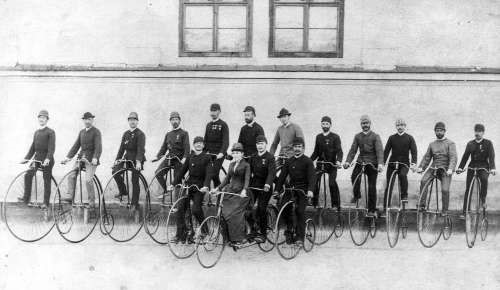
One of the one hundred cycling associations active in Hungary at the end of the 19th century.
The Millenáris track was buzzing with cycling life. At the end of the 19th century, there were twenty-one first-class cycle tracks in Hungary, as well as a hundred associations and a very well-functioning cycling association. Races were described in the newspapers, and picture magazines were keen on bicycle recreation. The competition was held with a large audience. The popularity of cycling races is evidenced by the fact that even a women's race was organized in which three cyclists took part.
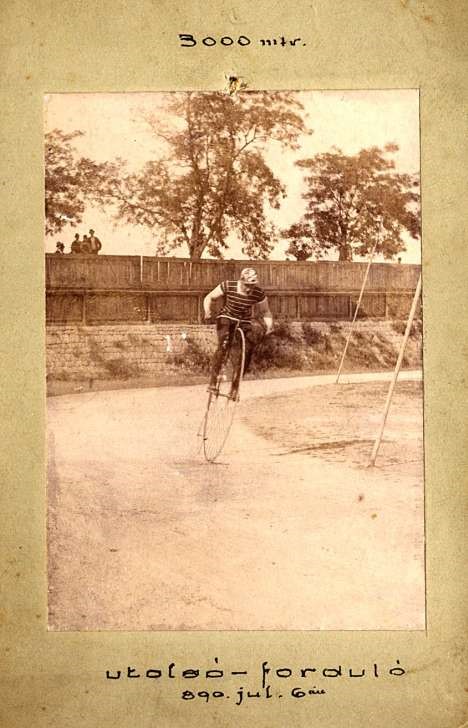
A race at the Hungarian Millenáris track – early 20th century
Unfortunately, a very dynamic sport has started to face more and more problems on its way. At the end of 1899, a tax of 5 crowns was introduced for each bicycle owner. On some streets, it is forbidden ride on bicycles. In addition, there were no factories in Hungary that could produce large quantities of cheap international class bikes. Slowly cycling started to be an expensive form of recreation. The resulting gap was quickly exploited by football, which soon became the most popular sport in Hungary. Within a few years the number of active cycling tracks decreased from twenty-one to six and the number of certified cyclists from four thousand to only four hundred. The only facility that continued to develop was Millenáris. The new grandstands were completed there, as well as the track, which after the reconstruction was five hundred meters long and seven meters wide on average. World-class cyclists came to Budapest for the competition and their fierce competition was observed by thousands of spectators. In 1907, the Hungarian Cycling Association launched an offensive to re-popularise cycling in Hungary. The rules of cycling races were reformed and new competitions were introduced. In 1911 the bicycle ownership tax was abolished. Both road and track races were organized. The best Hungarian riders took part in the 1912 Olympic Games in Stockholm for the first time. A year later they competed at the World Cup in Berlin.
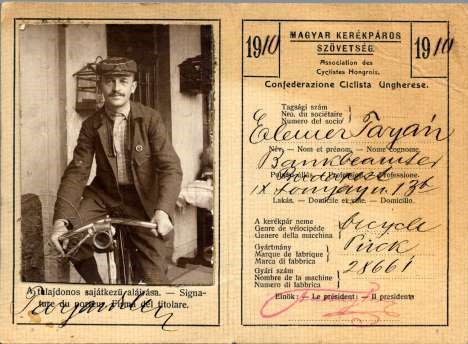
Hungarian Cycling Association membership card.
The outbreak of World War I was another turning point for cycling in Hungary. A large number of cyclists went to the front and some associations were forced to suspend their activities. The economic and organizational difficulties that followed the war hindered the development of cycling. It was not until 1923, when Hungary became a member of the International Cycling Federation again, that this sport began to develop. István Burghardt, István Széchényi and János Grimm. were the most eminent Magyar cyclists of that period. On 27 June 1925 the first Tour de Hongrie was organized - the biggest professional bicycle race in Hungary. The riders set off at four o'clock in the morning, and the 510-kilometre route (Budapest - Szombathely - Győr -Budapest) was the fastest to beat Károly Jerzsabek (in 22 hours and 10 minutes). In 1928 the Millenáris Stadium was rebuilt, which became the most modern concrete track in Europe. The Hungarian riders competed successfully in the international arena: László Vida was fourth in the World Road Race Championship, four years later Sebestyén Schmidt represented Hungary at the Olympic Games in Los Angeles. Over time, the Tour de Hongrie has become increasingly popular. In 1932 riders from seven countries appeared at the start line and the rally was extended to five days. In 1936 in Berlin the Hungarian colours at the Olympic Games were already represented by eight riders. László Orczán won fifth place in the time trial on 1000 meters. It was the greatest success of Hungarian cycling so far. The riders slowly caught up with their international rivals until World War II broke out.
During the war the competitions for the championship title and Tour de Hongrie races were still organized (however, over twice as long a distance as usual). After the end of the military operations, the largest bicycle rally in Hungary was organized sporadically, and between 1964 and 1992 there was a break of almost thirty years. The Magyars cyclists in international competitions, but they were far from the level presented by their colleagues before the war. In 1949 during the World Cycling Championship in Budapest István Pásztor won the 1000 meters time trial. At the Olympic Games in Helsinki a team of two: István Schillerwein and Imre Furmen came fifth and Béla Szekeres was sixth in an individual competition. In 1953 the World Cup was once again held on the Millenáris track in Budapest. The team of István Pásztor, Imre Furmen, János Bascsák and István Schillerwein won gold medals in the 4000 meter race. Two years later, at the European Criteria Competition in Berlin, this unchanged team took second place. At the 1967 World Cup in Amsterdam, Richard Bicskey and Ferenc Habony took fifth place on a two-seater tandem bike. The chase team at the World Championships in 1981 came in eighth place. Five years later a tandem cycling team: Péter Pais and Béla Pintér took seventh place.
In the early 1990s cycling in Hungary started to develop again intensively. At the 1991 World Cup, Péter Hohner and János Hegyes took seventh place. Since 1993, the Tour de Hongrie has been re-established. At the Olympic Games in Sydney in 2000, Szilvia Szabolcsi took fifth place in the 200-metre final. The first medal of the World Championship for Hungarians was won by László Bodrogi in 2000. At the World Championships in 2007 Bodrogi also took part in time trial and lead. This time he took second place. Hungarians are also successful in mountain biking. In 2004 Zsolt Viczeffy took part in the Olympic Games. Later this feat was repeated by András Parti, who took part in the Olympic Games in Beijing. The outstanding mountain biker Barbara Benkó, took part in the Olympic Games in London. She is also a multiple Hungarian champion in the off-road bike category. In 2007 she won a silver medal at the European Junior Championships and in 2008 at the World Junior Championships. The BMX series is also popular in Hungary. Her first national championship took place in 1990. Since 2007, the area of the Tour de Hongrie race route crossed the country's borders - one of the stages of the race ended in Košice, Slovakia. Forty-first edition of Tour de Hongrie is planned for 2020. Originally, the event was to take place from 13 to 17 May 2020, but it was postponed due to the coronavirus pandemic. After the changes, the start was scheduled for 29 August. The riders will leave Debrecen and finish the race in Esztergom on 2 September. A great success of Hungary is also the start of 103rd edition of the second biggest cycling event in the world - Giro d'Italia, planned for October. According to the organisers' announcements, the riders will start the race in Budapest.
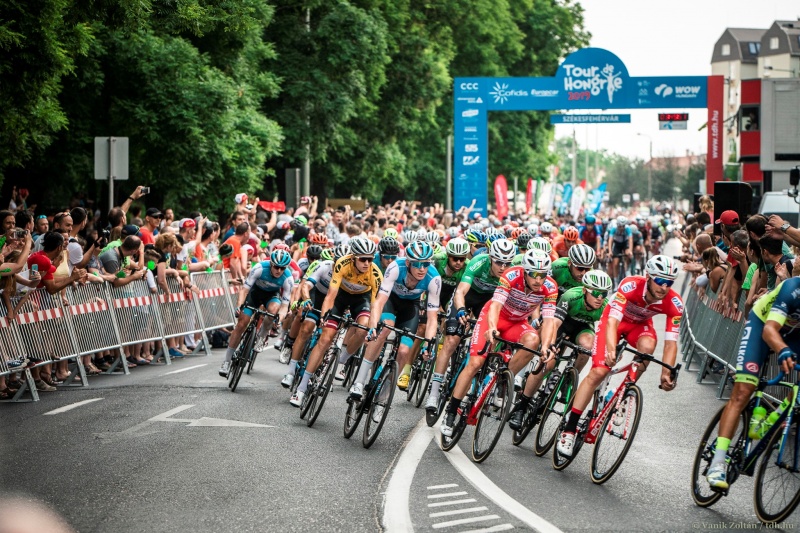
2019 Tour de Hongrie.
Hungary is at the forefront of European bicycle use. 22% of people use them as the main means of transport. Only the Dutch and the Danes are ahead of the men and women. Bicycle sport and recreation is also supported by the Hungarian government, which has declared the second half of 2020 and the first half of 2021 the year of cycling. Due to the possible forms of spending time (both commercial and recreational), the popularity of cycling is still growing. In its use, aspects of sustainable development, climate protection, national economy and traffic safety are important. Therefore, in July 2020, the "Year of Cycling" programme was announced in Hungary. Within its scope it is planned to purchase a large number of electric bicycles and to develop a concept for bicycle relations between Budapest and the capital city agglomeration. Great emphasis will be placed on the availability of stationary bicycle transport in the region, as well as on the directions of development of the pathway network. Work in this area will be coordinated by the Government Commissioner for Active Hungary. There are currently 9100 kilometres of bicycle routes in Hungary. Between 2014 and 2020, 200 billion forints were allocated for their modernisation. With the involvement of the Hungarian Bicycle Association, changes are currently being developed to further facilitate bicycle use. New tourist trails are being mapped out and bicycle service centres are being established. According to government

Michał Kawęcki, urodzony w 1987 roku. Politolog, założyciel i prezes Stowarzyszenia Sympatyków I. Lwowskiego Klubu Sportowego Czarni Lwów. Autor monografii najstarszego polskiego klubu piłkarskiego.
Sources:
http://Bikemag.hu – Hungarian magazine about bicycles and cycling
http://carpathianrace.eu - Carpathian Couriers Race in memory of Wacław Felczak
http://www.uec.ch – Hungarian Cycling Association website
https://www.tourdehongrie.hu – Tour de Hongrie website